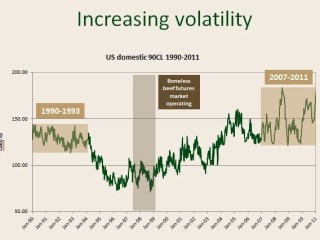 US meat importers were ‘receptive and inquisitive’ about a new lean beef futures contract model outlined to them by Australian Agricultural Company head, David Farley last week.
US meat importers were ‘receptive and inquisitive’ about a new lean beef futures contract model outlined to them by Australian Agricultural Company head, David Farley last week.
Mr Farley made a well-received presentation during the Meat Importers Council of America annual meeting in San Diego last Wednesday, which fostered a lengthy discussion on why boneless contracts in the US and Australia had failed in the past, and what has changed in the international trading environment that would foster support for a derivative contract of this type in the future.
Apparently influenced by his cotton industry background where futures is a widely used hedging tool, Mr Farley has over the past six months developed a 90CL ground beef futures model for which he is now seeking international support.
He argues that establishing a new futures market would provide a tool for beef producers, exporters and a growing fast-food service sector worldwide to better manage the risk of volatile beef prices.
The concept was first discussed on Beef Central in August.
Mr Farley said over the past two years beef producers had faced higher and more volatile prices (see graph below, with shaded area showing the relatively stable period when boneless beef futures was last operating) and he expected that trend to continue. Extensive drought in southern regions of the US was resulting in higher slaughter rates and the ongoing liquidation of the US herd.
 The current market for ground beef demonstrated many of the important characteristics required for creating a successful futures contract, he told the MICA annual meeting.
The current market for ground beef demonstrated many of the important characteristics required for creating a successful futures contract, he told the MICA annual meeting.
In 2010, global beef production amounted to 57 million tonnes, of which about 25 percent was ground beef or used for manufacturing purposes, Mr Farley said.
“As such, beef trim is a large and relatively homogenous product that is consumed and traded around the world with plenty of buyers and sellers.”
Mr Farley said with Australia and New Zealand currently supplying a substantial amount of the growing US and world demand for ground beef, such a contract would be attractive to producers, lotfeeders, processors, traders, hedge funds and speculators.
He suggested the proposed new contract had potential to be traded on either the Chicago or Singapore stock exchanges.
“A number of agricultural commodities are already recognised as an asset class and traded on futures markets and the time is right now to establish a ground beef futures contract to help producers better manage price risk,” he said.
Analysts back futures proposal
Respected US agribusiness analyst group Informa Economics has prepared a report on the Farley lean beef futures proposal, pointing out that risk management options are currently very limited for those that operate in the global lean beef market.
“At times, in the current market environment, lean beef suppliers will contract with users for delivery in a future time period at a fixed price. However this forces suppliers to bear more price risk than they desire and they often limit this business by setting offer prices for fixed price contracts at very high levels to compensate for the additional risk burden,” Informa said.
"A futures contract based on lean boneless beef would provide a valuable risk management mechanism that would allow commercial participants to offload risk and speculative interests to assume that risk in pursuit of market gains."
Futures on boneless beef have been tried in the past. From June 1997 to April 1999 (see shaded segment in graph above), the Chicago Mercantile Exchange listed a boneless beef futures contract for 90pc chemical lean trim.
Although met with initial enthusiasm, the contract had difficulty attracting volume and liquidity and fell into disuse relatively quickly. One of the reasons it failed was that the contract specifications narrowly focused on US market, rather than taking a global approach, as the latest model does, which would open-up participation on the supply side.
Informa pointed to the successful 40-year operation of pork belly futures in the US as evidence that it was possible to successfully trade futures contracts based upon meat items.
“We believe that boneless beef could be the pork bellies of the 21st century,” it’s report said.
“The product has all of the elements that generally lead to successful futures trading: a homogenous product with a large cash market, a large number of players on both sides of the market, considerable price volatility, low levels of government interference and a large deliverable supply.”
“With some careful study of the target market, a futures contract can be designed that will appeal to the broad international market in boneless beef. Such a contract has the potential to grow into a liquid risk management instrument for the beef industry and a nice addition to the CME’s portfolio of agricultural products.”
Mr Farley's lean beef futures concept is currently under scrutiny by Queensland’s AgForce Cattle board, with a view to taking a motion forward seeking endorsement by Cattle Council of Australia.
